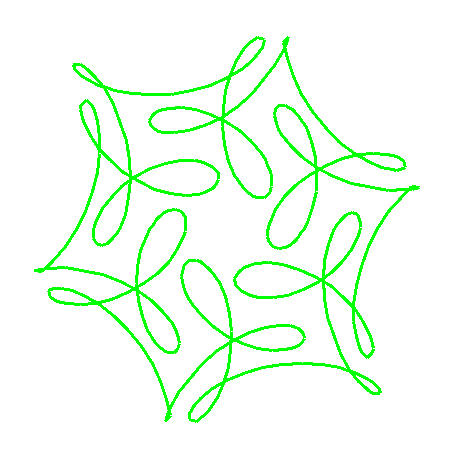| Including Maple graphics in LaTeX documents |
Since it is straightforward to
include graphics in PostScript format in a LaTeX document, it is useful to know how
to convert Maple plots into PostScript. The most flexible
method uses the Maple "plotsetup" command.
For example, open up Maple and execute the command
plot3d((1.3)^x*sin(y), x=-1..2*Pi, y=0..Pi,
coords=spherical, style=patch);
which should display a cornucopia. To create a PostScript file of this graph, execute the Maple command
plotsetup(postscript, plotoutput=`cornucopia.ps`,
plotoptions=`color,portrait,height=300,width=300`);
and then execute the plot3d command again. Now instead of
displaying the graph on the screen, Maple will write out to disk
a PostScript version of the graph. To view the PostScript file,
execute the command ghostview cornucopia.ps & at the
command prompt in a terminal window.
Note that the plotsetup command affects the whole Maple session. If you want to save several plots, you need to issue
several plotsetup commands with different values specified
for plotoutput. To make Maple revert to displaying plots
on the screen, issue the command plotsetup(default);.
If you simply say "plotsetup(postscript);" without specifying
a value for plotoptions, then Maple will by default create a
monochrome image, in landscape orientation, scaled to fill a
whole page, and with a border. You can add "noborder" to the
list of plotoptions to eliminate the border. The numbers
specified for the height and width of the image
have units of PostScript points. (There are 72 PostScript points in an inch.) However, the height and width
include margins of one-half inch on all sides of the image.
An alternative way to make a PostScript file of a Maple graph
is to display the graph in its own window (either set the
Plot Display on the Options menu to Window, or
issue the Maple command plotsetup(x11);) and then select
Print from the File menu. However, this alternate
method gives you less flexibility for setting options. Of course,
you can always rescale images inside LaTeX with the
\resizebox command.
If you want to include a Maple plot in a World-Wide Web page, you can replace "postscript"
in the "plotsetup" command with "jpeg" to
create a JPEG image or with "gif" to create a GIF image. Alternatively, you can convert an entire Maple worksheet into an HTML document by using the Export As
HTML feature on Maple's drop-down File menu.
Of course, if you wish to ignore the Maple plotsetup
command, then you can simply grab graphics off the screen with
a graphics program like xv. The disadvantage of this
method is that modifying your work in the future becomes
harder.
Exercise on "Farris wheels"
The mathematics in this exercise comes from the following article:
Frank A. Farris
Wheels on Wheels on Wheels--Surprising Symmetry
Mathematics Magazine 69 (1996), number 3,
185-189.
There is an interesting follow-up article:
Frank
A. Farris
and Nils Kristian Rossing
Woven Rope Friezes
Mathematics Magazine 72 (1999),
number 1, 32-38;
associated web site.
Start by examining the plot generated by the following Maple commands.
x := t -> cos(t) + cos(7*t)/2 + sin(17*t)/3; y := t -> sin(t) + sin(7*t)/2 + cos(17*t)/3; plot([x(t), y(t), t=0..2*Pi],axes=none,thickness=3,color=green);
 Your plot should look something like
the figure.
Notice that the plot has six-fold symmetry. Figure out why you
should be able to tell ahead of time from the equations that this
symmetry is present. (Hint: the numbers 7 and -17 are
both congruent to 1 modulo 6.)
Your plot should look something like
the figure.
Notice that the plot has six-fold symmetry. Figure out why you
should be able to tell ahead of time from the equations that this
symmetry is present. (Hint: the numbers 7 and -17 are
both congruent to 1 modulo 6.)
The physical interpretation is that the curve represents the position of a particle on a wheel whose center is mounted on the rim of a second wheel whose center is mounted on the rim of a third wheel, each wheel turning at a different rate.
Do you remember Euler's formula about complex exponentials? It
says that eit = cos(t) + i sin(t). You can get the
same plot using complex exponential notation as follows.
z := t -> exp(I*t) + exp(7*I*t)/2 + I*exp(-17*I*t)/3;
plot([Re(z(t)), Im(z(t)), t=0..2*Pi],
axes=none, thickness=3, color=green);
Next try plotting the curve given in exponential notation by z(t) = e-2it + (1/2)e5it + (1/4)e19it. How can you tell from the equation that the plot has 7-fold symmetry?
Write a LaTeX document explaining the symmetry of such figures and displaying some pretty plots of your own devising. (For example, can you find an attractive plot with 9-fold symmetry?) Be sure to identify the function that generates each figure you include in your paper.
 The Math 696 course
pages were last modified April 5, 2005.
The Math 696 course
pages were last modified April 5, 2005.| Including Maple graphics in LaTeX documents |